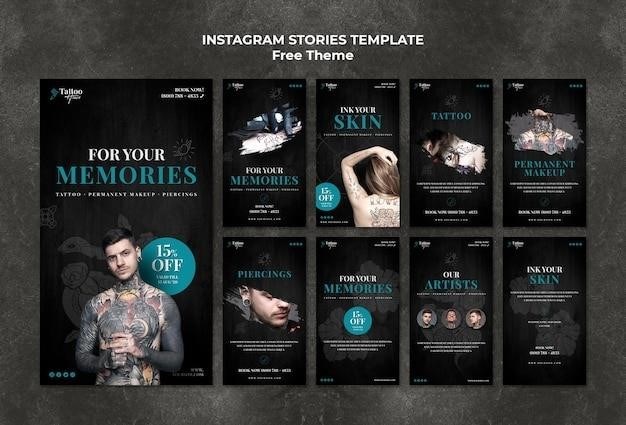These comprehensive tattoo aftercare instructions are designed to guide you through the healing process‚ ensuring optimal results and minimizing the risk of complications. This printable guide covers everything from initial bandage care to sun exposure‚ water‚ and common troubleshooting tips. Download and keep this handy reference to ensure your new tattoo heals beautifully.
Initial Bandage
The initial bandage applied after your tattoo is crucial for protecting the fresh skin and promoting healing. The bandage is typically a thin‚ sterile film dressing that allows the tattoo to breathe while keeping it clean and protected. This bandage is designed to be worn for a specific duration‚ usually between 1 and 6 hours‚ depending on the artist’s instructions and the type of bandage used.
It is essential to follow the artist’s guidance on bandage removal time. Removing the bandage too early can expose the tattoo to potential infection‚ while leaving it on for too long can trap moisture and hinder healing. When it’s time to remove the bandage‚ do so gently‚ avoiding any harsh pulling or tugging. Wash your hands thoroughly before handling the bandage and the tattoo.
Once the bandage is removed‚ you will likely see some plasma or fluid on the tattoo. This is normal and part of the healing process. However‚ if you notice any excessive bleeding‚ pus‚ or unusual redness‚ contact your tattoo artist or a medical professional immediately.
After removing the initial bandage‚ your tattoo artist may recommend a specific cleaning and moisturizing routine. Follow these instructions carefully to maintain a clean and healthy environment for your tattoo to heal properly.
Washing and Moisturizing
Keeping your tattoo clean and moisturized is essential for optimal healing. The initial few days are crucial‚ as the skin is still delicate and susceptible to infection. You’ll need to wash your tattoo gently but thoroughly twice a day‚ using a mild‚ unscented soap and warm water. Avoid harsh soaps‚ scrubs‚ or any products containing fragrances or alcohol‚ as these can irritate the sensitive skin.
When washing your tattoo‚ use your fingertips to gently cleanse the area‚ avoiding any rubbing or scrubbing. Rinse thoroughly with lukewarm water and pat the tattoo dry with a clean‚ soft towel. Do not rub the tattoo dry‚ as this can cause irritation and delay healing. After washing‚ apply a thin layer of unscented moisturizer‚ like Aquaphor or A&D ointment‚ to the tattoo. This will help to keep the skin hydrated and prevent dryness‚ which can lead to scabbing and scarring.
It’s important to use a moisturizer specifically designed for tattoos‚ as these are typically formulated to be gentle on the skin and promote healing. Avoid using petroleum-based products‚ as these can trap moisture and hinder the healing process. Continue this washing and moisturizing routine for the first 3-5 days‚ or as recommended by your tattoo artist.
After 5 days‚ you can switch to a quality unscented lotion‚ such as Lubriderm or Curel‚ for continued hydration. However‚ always consult your tattoo artist for their specific recommendations on moisturizers and the duration of your aftercare routine.
Sun Exposure and Water
Protecting your tattoo from the sun’s harmful rays is crucial‚ especially during the initial healing stages. UVA and UVB radiation can damage the skin‚ leading to fading‚ discoloration‚ and even scarring. For at least two weeks after getting your tattoo‚ minimize sun exposure as much as possible. When you must be outdoors‚ cover the tattoo with clothing or a waterproof bandage‚ and apply a broad-spectrum sunscreen with an SPF of 30 or higher to the surrounding area. Reapply the sunscreen every two hours‚ especially after swimming or sweating.
Water can also affect your tattoo’s healing process‚ so it’s important to be cautious. During the first few days‚ avoid soaking your tattoo in water for extended periods. This includes baths‚ hot tubs‚ swimming pools‚ and even long showers. Instead‚ opt for short‚ lukewarm showers and gently pat the tattoo dry with a clean towel.
Once the tattoo has started to heal‚ you can gradually increase your water exposure. However‚ it’s still best to avoid swimming in fresh‚ salt‚ or chlorinated water for at least two weeks. These environments can harbor bacteria and other microorganisms that could potentially infect your tattoo. If you must swim‚ cover your tattoo with a waterproof bandage or waterproof sunscreen.
Remember‚ these are general guidelines‚ and your tattoo artist may have specific recommendations based on your individual tattoo and healing process. Always follow their instructions for optimal results.
Healing Stages
Your tattoo will go through several distinct stages as it heals‚ each with its own characteristics and needs. Understanding these stages will help you identify what’s normal and what might require attention.
Initial Stage (Days 1-3)⁚ During the first few days‚ your tattoo will be red‚ swollen‚ and possibly tender. A thin layer of plasma may form on the surface‚ creating a crust or scab. This is a normal part of the healing process and helps protect the new skin. Avoid picking or scratching the scab‚ as this can increase the risk of infection and scarring.
Intermediate Stage (Days 4-10)⁚ The tattoo will begin to fade in redness and swelling. The crust or scab may start to flake off‚ revealing new skin underneath. The skin might feel itchy‚ but resist the urge to scratch. This stage is crucial for allowing the new skin to grow and mature.
Final Stage (Days 10-28)⁚ The tattoo will continue to fade in color and become less noticeable. The new skin will become more resilient and less prone to irritation. The healing process is typically complete within four weeks‚ although it can take longer for some individuals.
It’s essential to maintain proper hygiene and moisturizing throughout all stages. If you notice any unusual symptoms‚ such as excessive redness‚ swelling‚ pus‚ or pain‚ contact your tattoo artist or a medical professional immediately.
Troubleshooting
While most tattoos heal smoothly‚ there are instances where complications can arise. Understanding common issues and how to address them can help you maintain a healthy healing process. Here are some potential problems and solutions⁚
Infection⁚ Signs of infection include increased redness‚ swelling‚ pain‚ pus‚ or fever. If you suspect an infection‚ consult a medical professional immediately. They can prescribe antibiotics to treat the infection and prevent further complications.
Allergic Reaction⁚ An allergic reaction to tattoo ink is rare but can occur. Symptoms include itching‚ rash‚ redness‚ and swelling. If you experience an allergic reaction‚ stop using any lotions or products on the tattoo and consult a dermatologist. They can help determine the cause of the reaction and recommend appropriate treatment.
Scarring⁚ While most tattoos heal without noticeable scarring‚ some individuals may experience raised or depressed scarring. This can be caused by a variety of factors‚ including infection‚ picking at the scab‚ or excessive sun exposure. If you’re concerned about scarring‚ talk to your tattoo artist or a dermatologist for advice on minimizing its appearance.
Fading⁚ Tattoo fading is a natural process‚ but it can be accelerated by sun exposure‚ harsh soaps‚ and improper care. Following the aftercare instructions diligently and protecting your tattoo from the sun will help preserve its vibrancy for longer.
If you encounter any issues with your tattoo’s healing‚ don’t hesitate to seek professional advice. Your tattoo artist or a medical professional can provide guidance and treatment to ensure a successful outcome.
Printable PDF
For your convenience‚ we’ve created a printable PDF version of these tattoo aftercare instructions. This handy guide provides you with all the essential information you need to ensure proper healing and maintain the vibrancy of your new tattoo. The PDF format allows you to easily print and keep a copy readily available for reference throughout the healing process.
The printable PDF covers all the key aspects of tattoo aftercare‚ including⁚
- Initial bandage care
- Washing and moisturizing techniques
- Sun exposure and water precautions
- Healing stages and expected changes
- Troubleshooting tips and potential complications
- Additional tips for optimal healing
- Important considerations for long-term tattoo care
Download and print your copy today to ensure you have the necessary information at your fingertips. This comprehensive guide will help you navigate the tattoo healing process with confidence and achieve the best possible results for your new artwork.
Additional Tips
While following the core aftercare instructions is crucial‚ there are a few additional tips that can further enhance the healing process and minimize the risk of complications. Here are some helpful suggestions to keep in mind⁚
- Avoid scratching or picking⁚ Resist the urge to scratch or pick at your tattoo‚ even if it feels itchy. This can disrupt the healing process and increase the risk of infection. If you experience intense itching‚ consider applying a cold compress or consulting your tattoo artist.
- Wear loose-fitting clothing⁚ Opt for loose-fitting clothing that allows your tattoo to breathe and prevents friction‚ especially during the initial healing stages. Tight clothing can trap moisture and irritate the healing skin.
- Avoid direct heat exposure⁚ Limit exposure to direct heat sources like saunas‚ hot tubs‚ and prolonged sunbathing. Heat can dehydrate the skin and hinder the healing process. If you must be in a hot environment‚ cover your tattoo with loose-fitting clothing.
- Stay hydrated⁚ Drinking plenty of water is essential for overall health and can also promote proper skin hydration‚ which is vital for tattoo healing. Aim for eight glasses of water per day.
Remember that these tips are supplemental to the core aftercare instructions. Always consult with your tattoo artist if you have any concerns or questions regarding your specific tattoo and its healing process.
Important Considerations
While proper aftercare is paramount for a successful tattoo healing experience‚ there are certain considerations that deserve special attention. These factors can significantly impact the healing process and the overall outcome of your tattoo. Here’s what you need to be mindful of⁚
- Underlying medical conditions⁚ If you have any pre-existing medical conditions‚ such as diabetes‚ autoimmune disorders‚ or compromised immune systems‚ it’s essential to discuss them with your tattoo artist and healthcare provider before getting a tattoo. They can advise on potential risks and precautions to take during the healing process.
- Medications⁚ Certain medications‚ including blood thinners‚ steroids‚ and antibiotics‚ can affect the healing process. Inform your tattoo artist and doctor about any medications you are taking to ensure a safe and optimal healing outcome.
- Allergic reactions⁚ While rare‚ allergic reactions to tattoo ink ingredients can occur. If you notice any unusual symptoms like redness‚ swelling‚ itching‚ or rash beyond the initial healing phase‚ seek medical attention immediately.
- Sun exposure⁚ Sun exposure can fade tattoo colors and damage the skin‚ especially during the initial healing stages. Always protect your tattoo from direct sunlight with sunscreen or protective clothing.
By carefully considering these important factors‚ you can ensure a smoother healing process and a beautiful‚ long-lasting tattoo.
Disclaimer
The information provided in these tattoo aftercare instructions is intended for general knowledge and informational purposes only. It should not be considered a substitute for professional medical advice‚ diagnosis‚ or treatment. Always consult with a qualified healthcare professional for any health concerns or before making any decisions related to your health or treatment.

While we strive to ensure the accuracy and up-to-date nature of this information‚ it is subject to change. We cannot guarantee that the information is always complete‚ accurate‚ or current. It is essential to rely on the advice of your tattoo artist and healthcare provider for personalized guidance.
The use of this information is at your own risk. We are not responsible for any harm or injury that may occur as a result of relying on this information. Always consult with a qualified healthcare professional for any health concerns or before making any decisions related to your health or treatment.



Leave a Reply
You must be logged in to post a comment.